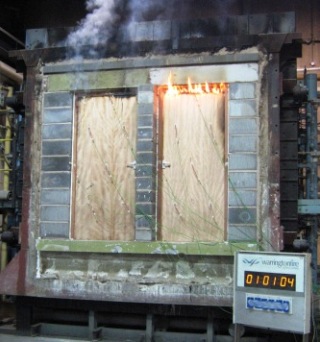 Iain McIlwee, BWF Chief Executive,
Iain McIlwee, BWF Chief Executive,
At the House of Lords last month, it was useful to hear Minister Brandon Lewis outlining government strategy on fire safety. Mr Lewis highlighted that fire prevention and protection must come first in everything. There were certainly some positive numbers being used, including the fact that attendance at fires is down 63%, overall fires down about 40% and there has been a 35% reduction in domestic fatalities in 5yrs. This underpins the work we are all doing to make buildings safer, but we should not be complacent (the statisticians amongst you will note that whilst the your chance of dying in a fire has gone down, if you do find yourself in a fire, the chance of not making it out have gone up). Sadly, despite best efforts from the majority, the few can let us down, as we saw recently in Stoke.
The Minister reiterated that fire safety is reliant on best buildings, best products and best services and asked "how does competency become the norm?". He wants to see more collaboration, a joined up approach driving innovation – he wants to encourage the fire industry to work more effectively together in delivering safer built environments.
Less positive news followed from the insurance sector who raised concern about the increasing cost of fire, which last year hit a record high – £3.4 million per day is the cost of fire. This cost is increasing at “an alarming rate” and does not include business interruption costs, which are also spiralling. Overall the cost of individual fires is increasing faster than inflation with arson accounting for about half of all fires. This very insightful presentation opened the door for me to question how the insurance sector is addressing this problem, supporting the link between product manufacturers and building owners to improve product specification and stop the specification breaking that is endemic and reduces the performance of buildings. I'll be honest the answer was vague, but we have already raised several suggestions here and have started the follow-up post event.
The theme of Fire Engineering and the focus on statutory requirements was raised as a concern by other speakers. Whilst this focus rightly prioritises life safety and evacuation, the wider cost and impact of a fire incident is often overlooked for design or, of more concern, to cut cost. Less compartmentalisation was used as an common theme, but seriously increases the chance of fire spreading more rapidly. This creates a problem for the emergency services as, by the time they arrive, they are not dealing with a fire in a building, but a building that is on fire. The view of the representative of the insurance sector was that commercial buildings designed with only statutory requirements are under-protected they do not minimise business interruption and content damage.
 Kevin Hulin also questioned whether fire engineering went far enough with a presentation that stressed the need for good practice – in particular knowing how products interact in a fire (compatibility) – and how education is essential. If you haven’t seen it, the GGF video is a stark reminder of what happens if you get it wrong. ARUP reinforced this message by restating that compliance with current codes only addresses life safety and that exclusive focus on life safety can have a detrimental effect on property and business. Fire Engineering should be about developing strategy to meet wider goals within the budget constraints. Fire Safety Goals should be set and communicated at the beginning of the building design process and stakeholders including insurers/procurement should also be consulted at this phase. This presentation finished with a question "Who sets objectives?". He reinforced that the standard of passive fire safety is being eroded. Sprinkler systems, designed and maintained do make a difference, but expressed the opinion that alternative active solutions do not have same pedigree and results.
Kevin Hulin also questioned whether fire engineering went far enough with a presentation that stressed the need for good practice – in particular knowing how products interact in a fire (compatibility) – and how education is essential. If you haven’t seen it, the GGF video is a stark reminder of what happens if you get it wrong. ARUP reinforced this message by restating that compliance with current codes only addresses life safety and that exclusive focus on life safety can have a detrimental effect on property and business. Fire Engineering should be about developing strategy to meet wider goals within the budget constraints. Fire Safety Goals should be set and communicated at the beginning of the building design process and stakeholders including insurers/procurement should also be consulted at this phase. This presentation finished with a question "Who sets objectives?". He reinforced that the standard of passive fire safety is being eroded. Sprinkler systems, designed and maintained do make a difference, but expressed the opinion that alternative active solutions do not have same pedigree and results.
In subsequent presentations, David Crowder of BRE also drew attention to the lack of attention paid to Regulation 7 (Materials and Workmanship) as well as Regulation 38 (this was reiterated by other speakers). David Curry highlighted issues and lessons from previous incidents (Lakanal House, Atherton, House fires etc) stating the time to learn is NOT in front of a burning building, and as Chairman of the PFPF Mike Wood spoke about the need to harmonise listing of fire safety products, we have made a start with the Fire Door Installers Register and will be helping Mike to bang this drum.
 It is always helpful to have these debates with Parliamentarians present and to enable the industry to distill the messages, but it is clear that the sector remains fragmented and we should do all we can to build the appropriate bridges with the wider industry, this is our responsibly as providers of fire safety products. A statistic that stood out on the day is that 14% of all fire risk assessments (under the RRO) are non-compliant – this means approximately one in 8 buildings are not deemed safe – this is surely not good enough. It is great to see British Sprinkler Week following the lead of Fire Door Safety Week and we will do our part by supporting the spread of the messages from colleagues in the active fire protection community. Collaboration is happening and getting better, so the future should be rosy… Right?
It is always helpful to have these debates with Parliamentarians present and to enable the industry to distill the messages, but it is clear that the sector remains fragmented and we should do all we can to build the appropriate bridges with the wider industry, this is our responsibly as providers of fire safety products. A statistic that stood out on the day is that 14% of all fire risk assessments (under the RRO) are non-compliant – this means approximately one in 8 buildings are not deemed safe – this is surely not good enough. It is great to see British Sprinkler Week following the lead of Fire Door Safety Week and we will do our part by supporting the spread of the messages from colleagues in the active fire protection community. Collaboration is happening and getting better, so the future should be rosy… Right?
My concern remains and was vocalised by my final question of the day, collaboration is great, but if we are confronted by an audience intent on shaving cost, ignoring critical messages and turning a blind eye to poor site skills, with little incentive to improve in a harshly competitive construction sector, is collaboration enough? If this is the reason we are not building buildings properly, to make positive impact fast – at some point we do need to consider legislating the process more effectively? Surely this is the most effective way to ensure the right products are selected and the people who install them competent. A good coat of plaster and a nice veneer can hide some pretty serious problems, if we do not take responsibility, the consequences could be devastating. The time to learn is not in front of a burning building (nor at the graveside!).